Death by playing cards
Oct 20, 1930: Convict William Kogut, who was waiting execution on San Quentin's death row, somehow knew that it was possible to make a bomb out of playing cards. This was because, at the time, the red ink of cards contained nitrocellulose. So by scraping off enough of the red ink, Kogut was able to make a pipe bomb out of a hollow bedpost. He used this to kill himself, rather than letting himself be executed.
Modern playing cards no longer contain this explosive ingredient.
Somewhat confusingly, Snopes classifies his death as a "legend," even though their brief write-up seems to confirm that it happened exactly as described.
More info: theatrefx.com

Modern playing cards no longer contain this explosive ingredient.
Somewhat confusingly, Snopes classifies his death as a "legend," even though their brief write-up seems to confirm that it happened exactly as described.
More info: theatrefx.com

Oroville Mercury Register - Oct 20, 1930
Comments
This is also featured in the book 'Still Life With Woodpecker':
https://en.wikipedia.org/wiki/Still_Life_with_Woodpecker
https://en.wikipedia.org/wiki/Still_Life_with_Woodpecker
Posted by S. Norman on 06/23/21 at 10:49 AM
From the book:
THE HEARTS AND DIAMONDS BOMB:
Take a deck of ordinary playing cards, the old-fashioned paper kind, cut out the red spots and soak them overnight like beans. Alcohol is the best soaking solution, but tap water will suffice. Plug one end of a short length of pipe. Pack the soggy hearts and diamonds into the pipe. One pre-plastic playing cards, the red spots were printed with a diazo dye, a chemical that has an unstable, high-energy bond with nitrogen. So you’ve got some nitro, of sorts, now you’ll be needing glycerin. Hand lotion will work nicely. Glug a little lotion into the pipe. To activate the quasi-nitroglycerin, you’ll require potassium permanganate. That you can find in the snake-bite section of any good first-aid chest. Add a dash of the potassium permanganate and plug the other end of the pipe. Heat the pipe. A direct flame is best, but simply laying the pipe atop a hot radiator will turn the trick. Take cover! The Woodpecker used a hearts and diamonds bomb to release himself from McNeil Island the first time that he was confined there.
THE HEARTS AND DIAMONDS BOMB:
Take a deck of ordinary playing cards, the old-fashioned paper kind, cut out the red spots and soak them overnight like beans. Alcohol is the best soaking solution, but tap water will suffice. Plug one end of a short length of pipe. Pack the soggy hearts and diamonds into the pipe. One pre-plastic playing cards, the red spots were printed with a diazo dye, a chemical that has an unstable, high-energy bond with nitrogen. So you’ve got some nitro, of sorts, now you’ll be needing glycerin. Hand lotion will work nicely. Glug a little lotion into the pipe. To activate the quasi-nitroglycerin, you’ll require potassium permanganate. That you can find in the snake-bite section of any good first-aid chest. Add a dash of the potassium permanganate and plug the other end of the pipe. Heat the pipe. A direct flame is best, but simply laying the pipe atop a hot radiator will turn the trick. Take cover! The Woodpecker used a hearts and diamonds bomb to release himself from McNeil Island the first time that he was confined there.
Posted by S. Norman on 06/23/21 at 10:52 AM
Nitrocellulose was also used in early motion picture film — leading to explosions and fires. That, combined with its tendency to decay, is why so many films made in the early 20th century are now lost.
Posted by Brian on 06/24/21 at 03:39 PM
Commenting is not available in this channel entry.

Category: Death | Suicide | Prisons | 1930s